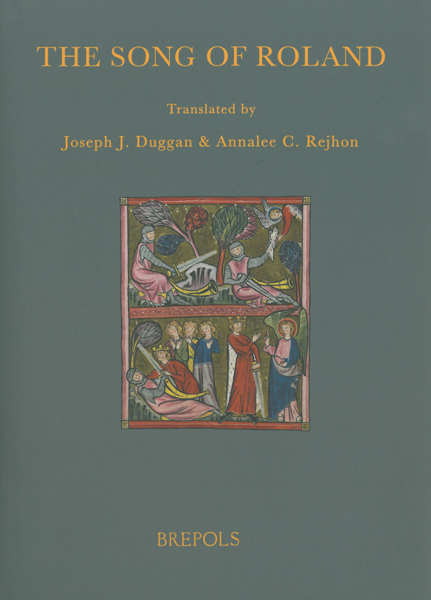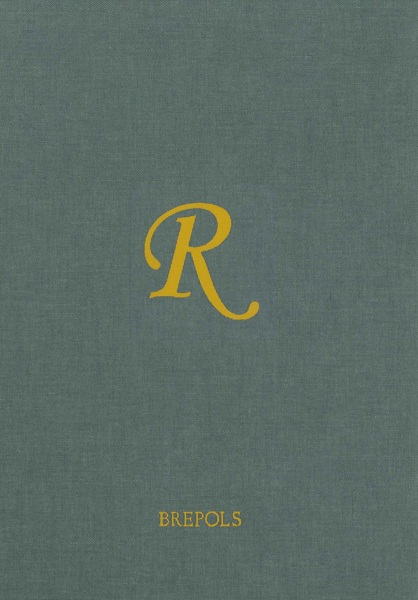
La Chanson de Roland - The Song of Roland: The French Corpus
Joseph J. Duggan (ed)
- Pages:3 vols, 2940 p.
- Size:155 x 210 mm
- Illustrations:10 b/w
- Language(s):English, French
- Publication Year:2006
- € 165,00 EXCL. VAT RETAIL PRICE
- ISBN: 978-2-503-51827-5
- Hardback
- Available
This edition brings together for the first time all the French texts of the Song of Roland, edited according to the highest scholarly standards. No reliable complete edition of the various versions of the French corpus of this poem, the most important of the chansons de geste and a recognized masterpiece of world epic, has been available until now.
Seven specialists in medieval French literature have collaborated on this edition:
Ian Short, Birkbeck College, University of London, for the Oxford version
Robert F. Cook, University of Virginia, for the Venice 4 version
Joseph J. Duggan, University of California, Berkeley, for the Châteauroux-Venice 7 version
Annalee C. Rejhon, University of California, Berkeley, for the Paris version
†Wolfgang van Emden, University of Reading, for the Cambridge version
William W. Kibler, University of Texas, Austin, for the Lyon version and the fragments
Karen Akiyama, University of California, Berkeley, for the concordance of laisses
Two of the texts, Oxford (3,995 ll., in a manuscript from the second quarter of the 12th century) and Venice 4 (6,011 ll., 14th-century MS), follow the tradition in assonance. The other five substantial texts, plus three fragments, are in rhyme: Châteauroux and Venice 7 (8,203 and 8,333 ll. respectively, both end of the 13th century), Paris (6,828 ll., acephalic, third quarter of the 13th century), Cambridge (5,695 ll., acephalic, first half of the 15th century), Lyon (2,932 ll., acephalic, late 13th or early 14th century), and the Lavergne, Bogdanow, and Michelant fragments (108, 160, and 352 ll. respectively, all late 13th century).
The General Editor, Joseph J. Duggan, wrote the general introduction, a history of the successive editions of the Song of Roland. Karen Akiyama’s concordance of laisses allows the reader easily to compare the versions. A complete list of works cited in the edition of the corpus is provided.
Each edition is based on a new transcription made directly from the manuscript. The editorial method corresponds to the nature of each text. An introduction that treats questions of codicology, philology, and method introduces each text, and each is provided with a critical apparatus of rejected readings and paleographic notes, explanatory notes, an index of proper names, and a glossary of words and forms that are not found in the standard desk dictionaries of Old French.
Ian Short presents the Oxford version, which has been edited 26 times since its rediscovery in 1833. Short follows an innovative and interventionist editorial technique, taking advantage of Oxford’s formulaic language and correcting the text in accordance with the poet’s linguistic and stylistic usage. This textof Oxford will be regarded as a landmark in the history of editions of Oxford. The Robert Cook edition of Venice 4, a text written in a hybrid language that combines French and Italian features, is specially adddressed to fit the needs of scholars immersed in the tradition of French epic. Châteauroux and Venice 7, lightly sprinkled with Italianate forms, are cognate versions, perhaps even copied in the same scriptorium. Joseph Duggan reconstructs the common model of the two texts while providing the complete text of Châteauroux in an appendix. Annalee Rejhon places the Paris version in the context of the cyclical manuscript in which it has survived, a compilation of poems tracing the deeds of the traitor Ganelon’s lineage. Wolfgang van Emden’s Cambridge edition is the first attempt to correct the readings of this idiosyncratic version. William Kibler’s Lyon is the first correctly transcribed text of this version. His edition of the fragments brings the three together for the first time.
The versions vary substantially. The episode of Aude, 30 lines in Oxford, is expanded greatly, becoming at its fullest extension a 956-line episode in the model of Châteauroux and Venice 7. The Venice 4 version includes a 570-line episode, the taking of Narbonne, found nowhere else. The episode of Baligant, a thousand lines in Oxford, is omitted from the Lyon version. In the rhymed texts, new episodes are added (the miracle of the hawthorn bushes, the miracle of the hazel trees, Ganelon’s two escapes, the deliberation over how to execute the traitor) and the trial of Ganelon is entirely recomposed. In addition, there are hundreds of other differences of detail among the versions, on the levels of plot and phrasing. Each version is a substantial retelling of the legend of the Battle of Roncevaux and its causes and aftermath, a narrative that changes according to the needs and tastes of a succession of evolving social and cultural contexts.
Cette édition réunit pour la première fois tous les textes français de la Chanson de Roland, édités selon les critères en vigueur de la philologie. Voici donc enfin une édition de référence complète du corpus français de cette chanson de geste, la plus importante du genre et chef-d’œuvre reconnu de l’épopée mondiale.
Sept spécialistes de la littérature française du Moyen Age ont collaboré à cette édition:
Ian Short, Birkbeck College, Université de Londres pour la version d’Oxford
Robert F. Cook, Université de Virginie pour la version de Venise 4
Joseph J. Duggan, Université de Californie, Berkeley pour la version de Châteauroux-Venise 7
Annalee C. Rejhon, Université de Californie, Berkeley pour la version de Paris
†Wolfgang van Emden, Université de Reading pour la version de Cambridge
William W. Kibler, Université du Texas, Austin, pour la version de Lyon et les fragments
Karen Akiyama, Université de Californie, Berkeley pour la concordance des laisses
Deux des textes, Oxford (3.995 vv., dans un manuscrit qui date du deuxième quart du XIIe siècle) et Venise 4 (6.011 vv., ms. du XIVe siècle) suivent la tradition assonnancée. Les cinq autres textes substantiels et les trois fragments sont en rimes: Châteauroux et Venise 7 (respectivement 8.203 et 8.333 vv., tous deux de la fin du XIIIe siècle), Paris (6.828 vv., acéphale, troisième quart du XIIIe siècle), Cambridge (5.695 vv., acéphale, première moitié du XVe siècle), Lyon (2.932 vv., acéphale, fin du XIIIe ou début du XIVe siècle), et les fragments Lavergne, Bogdanow et Michelant (108, 160 et 352 vv. respectivement, tous de la fin du XIIIe siècle).
L’éditeur en chef, Joseph J. Duggan, a rédigé l’Introduction générale, une étude des éditions successives de la Chanson de Roland. La concordance des laisses, établie par Karen Akiyama, facilite la comparaison des versions. La bibliographie renvoie à tous les ouvrages cités dans l’édition du corpus.
Chaque édition se base sur une nouvelle transcription du manuscrit. La méthode éditoriale diffère en fonction de la nature de chaque texte. Une introduction qui traite les questions de codicologie, de philologie et de méthode, accompagne le texte, ainsi qu’un apparat de leçons rejetées et de notes paléographiques, des notes explicatives, un index des noms propres, et un glossaire des mots et des formes qui ne se trouvent pas dans les dictionnaires usuels de l’ancien français.
Ian Short présente la version d’Oxford, éditée 26 fois depuis sa redécouverte en 1833. Il y utilise une technique éditoriale à la fois innovatrice et interventionniste tout en ayant recours à la langue formulaire propre à l’épopée, et corrige le texte d’une façon qui correspond aux caractéristiques linguistiques et stylistiques du poète. Ce texte d’Oxford sera considéré comme un monument marquant dans l’histoire des éditions de cette version. L’édition Cook de Venise 4, texte écrit dans une langue hybride qui combine le français et l’italien, s’adresse tout particulièrement au chercheur spécialisé dans la chanson de geste. Les versions congénères de Châteauroux et de Venise 7, peut-être copiées dans le même scriptorium, incorporent elles aussi des traits de la langue italienne de leurs copistes. Joseph Duggan reconstruit le modèle commun des deux textes tout en fournissant le texte intégral de Châteauroux en annexe. Annalee Rejhon situe la version de Paris dans le contexte du manuscrit cyclique dans lequel il nous est parvenu, une compilation qui retrace les faits et gestes de la descendance du traître Ganelon. L’édition de Cambridge de Wolfgang van Emden représente la première tentative pour corriger les leçons de cette version sui generis. L’édition de Lyon de William Kibler est la première transcription exacte de cette version. Son édition des fragments les regroupe tous les trois pour la première fois.
Les versions varient beaucoup entre elles. L’épisode d’Aude, 30 vv. dans Oxford, est considérablement allongé dans tous les autres textes, comptant jusqu’à 956 vv. dans le modèle de Châteauroux et Venise 7. La version de Venise 4 comprend un épisode unique de 570 vv. qui raconte la prise de Narbonne. L’épisode de Baligant, mille vers dans Oxford, est omis dans Lyon. Dans les versions en rime de nouveaux épisodes viennent s’ajouter à la narration (le miracle des aubépines et celui des coudriers, les deux fuites de Ganelon, le débat sur la manière dont le traître mourra) et le procès de Ganelon est entièrement révisé. Par ailleurs, on trouvera des centaines de différences de détails entre les versions, que ce soit au niveau de l’action ou de l’expression. Chaque version représente en fait une nouvelle actualisation de la légende de Roland et de la bataille de Roncevaux, ses causes et ses effets, récit qui change en fonction des goûts et des besoins de contextes socioculturels qui ont évolué au cours des âges.

